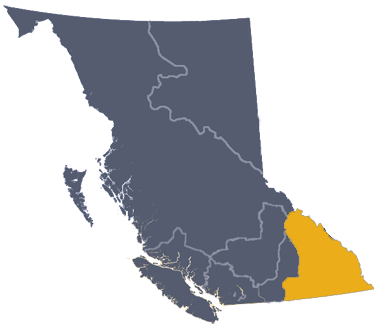Kootenay and Boundary - Overview
The Kootenay and Boundary regions feature high mountain slopes and wide, fertile valleys. The relatively remote location creates strong local demand and is fueling an emerging processing sector that produces added-value meat, honey, fruit, dairy, wine, and wool.
Growing conditions
The Kootenay & Boundary regions have moderate climates, allowing for a wide range of crops. Higher mountain areas provide grazing for a large beef cattle sector, while the Creston Valley produces abundant crops.
Crops, livestock and food processing
Products include apples, cherries and other tree fruits, tomatoes, vegetables, forage, forage seeds, cereals and oilseeds. In addition to summer Crown-land grazing, the cattle sector is supported by forage crops, which grow well in the river valleys. Livestock production in this region includes extensive beef and dairy cattle production as well as poultry, goats and specialty livestock like llamas.
Local Kootenay information
Find out more specific information about the Kootenay agricultural region:
Regional agrologists
Jeff Nimmo - Kootenays
Telephone: 778-666-0568
Email: Jeffrey.Nimmo@gov.bc.ca
Lindsay Hainstock – Boundary Country
Telephone: 250 485-7859
Email: Lindsay.Hainstock@gov.bc.ca
Resources
The ministry has developed regional guides as a resource for producers, on-the ground researchers, and consultants to reflect on the climate issues challenging environmental sustainability and local farm businesses and food production.
- The Kootenay Soil Building Network is an ongoing project in partnership with the Kootenay Boundary Farm Advisors. The network uses online virtual meetings and on farm demonstrative work to help share knowledge and improve soil health in our region.
- Find resources and recordings of past discussions on our Kootenay Soils website
- From Loss to Recovery: Managing Cherry Orchards After Winter Damage. A video summary of management strategies from field visits in the Creston Valley and Okanagan - after significant winter damage in 2024.
AgriService BC - Kootenay & Boundary regional newsletter
Learn about what's happening and opportunities in our region! Sign up for the monthly AgriService BC: Kootenay & Boundary regional newsletter

The Kootenay & Boundary region includes East Kootenay Regional District (Cranbrook, Invermere); Central Kootenay Regional District (Creston, Nakusp, Nelson); Kootenay Boundary Regional District (Grand Forks, Rossland, Trail), Columbia Shuswap Regional District Areas A and B (Revelstoke, Golden).
Contact information
AgriService BC
Have a question? Call or email and a staff person will assist you.
Telephone: 1-888-221-7141
Email: AgriServiceBC@gov.bc.ca
